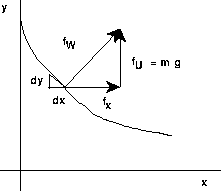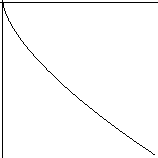
Figure 12.1: Isochrone Forces
A bead slides along a frictionless wire and starts with an initial downward velocity v0. Find the shape of the wire that maintains a constant downward component of velocity. In other words, find the shape that converts all the gravitational energy into new horizontal kinetic energy. Rather than an energy argument, we will begin by finding equations of motion using Newton's law, F=mA, or total applied force equals mass times the second derivative of position. Since the wire is frictionless, it can only produce a force perpendicular to the bead. Since the vertical speed cannot increase, the weight of the bead, mg must equal the upward portion of the wire force. This is shown in the rough sketch Figure 12.1.

The fact that the force from the wire is perpendicular to the wire means that a tiny incremental triangle along the wire is similar to the triangle of forces, yielding

We may use the Chain Rule to express the geometric slope in terms of the horizontal and vertical speeds,

The vertical speed,
 , is to remain constant (since we balanced the force of gravity with the upward component of wire force), so
, is to remain constant (since we balanced the force of gravity with the upward component of wire force), so

The horizontal motion is goverened by Newton's F=mA law,


Now use the phase variable trick; let
 so the equation above becomes
so the equation above becomes


Use the equation for
 to show that the horizontal position is given by
to show that the horizontal position is given by

We also know (if we measure y downward, so its velocity is positive) that
 .
.

We can solve the y equation fot t=y/v0 and substitute into the horizontal position equation, obtaining
 .
.
 .
.

We have found several equations for the isochrone.

12.1
The equations for the isochrone can also be found from an energy argument.
You need to know that the increase in kinetic energy changing from
How could you find the equation for x(t) from this equation?
 to a higher horizontal speed u is
to a higher horizontal speed u is

You also need to know that the decrease in gravitational potential energy in moving down a distance y is

The physical principle of conservation of energy (which we showed for a linear oscillator in Chapter 17 of the main text) says these two quantities are equal, so


Then separate variables and show that

as before.